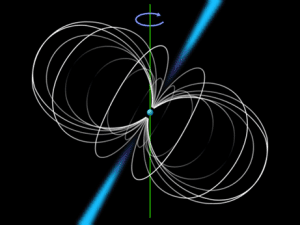TAG: GS 3: SCIENCE AND TECHNOLOGY
THE CONTEXT: The discovery of pulsars led scientists to unravel the connection with neutron stars, born from the remnants of heavy star cores.
EXPLANATION:
- When these massive stars collapse, they either form black holes or condense into neutron stars, ultra-dense objects where gravity battles against neutron repulsion, creating a delicate equilibrium.
- Pulsars, it turned out, were rotating neutron stars emitting periodic signals akin to a lighthouse sweeping its beam across the sea.
Pulsars and Neutron Stars
- In 1967, amidst global events like the Nathu La and Cho La clashes and the Vietnam War, astronomers at the University of Cambridge stumbled upon a cosmic puzzle.
- Jocelyn Bell Burnell and Antony Hewish, while studying radio waves from distant stars, discovered the first pulsar, PSR B1919+21, setting the stage for a captivating journey into the mysteries of neutron stars.

A schematic diagram of a pulsar
The Eureka Moment and a Mysterious Glitch
- As scientists delved into understanding pulsars, a momentous discovery emerged in 1969.
- Two independent research groups reported an abrupt increase in the rotation rate of the pulsar PSR 0833-45 – a glitch that defied explanation for 44 years.
- Despite the subsequent identification of over 3,000 pulsars and around 700 glitches, the origin of these glitches remained elusive.
The Curious Features of Glitches
- Upon plotting the rotation rates of pulsars over time, scientists observed a peculiar pattern during glitches.
- The rotation briefly increased before returning to its original value.
- Notably, the slow post-glitch relaxation indicated that the neutron star’s interior harbored a superfluid – a frictionless state of matter with remarkable properties.
Superfluids and Vortices
- Superfluids, when set in motion, exhibit unique behavior, forming vortices.
- In the neutron star, the crust, believed to be a lattice of nuclei, coexists with a superfluid core.
- The vortices within the superfluid become pinned to the nuclei, resisting rearrangement.
- As the star loses energy, the crust slows down, leading to a force on the vortices that overcomes pinning.
- This results in a brief increase in rotation, causing the observed glitch.
Contested Details and Scientific Inquiry
- While the overarching mechanism of glitches involving superfluids and vortices is accepted, several details remain hotly contested.
- The trigger in space and the evolutionary dynamics of glitches are areas of ongoing scientific inquiry.
- The study of pulsar glitches provides a unique window into the complex physics unfolding inside neutron stars, offering insights that could reshape our understanding of these enigmatic celestial bodies.
Conclusion
- In the words of Ghalib, “The stars are one thing and appear another, these tricksters fool us openly.”
- The pulsar glitch, a cosmic riddle, continues to captivate physicists, urging them to probe deeper into the intricate workings of neutron stars and superfluids.
- The journey from the discovery of pulsars in 1967 to the unresolved glitch mystery of 2024 highlights the enduring fascination and challenges within the realm of astrophysics.

